Long-Term Test: 2010 Dodge Ram 2500 Laramie Mega Cab 4x4 Diesel

Departure Date: August 2011
Current Mileage: 40,848 miles
Months in Fleet: 16 months
Average Fuel Economy: 14 mpg
Average Range: 476 miles
Service: $1198
Normal Wear: $0
Repair: $0

Pickup sales are a popular indicator of housing-market health, but the inhabitants of the house that Walter P. Chrysler built were worrying about other measures of fiscal fitness at the time this heavy-duty Ram was introduced. Between the truck’s first public appearance at the February 2009 Chicago auto show and its launch nine months later, Chrysler filed for and emerged from bankruptcy. During that same time, new housing construction hit its low inflection point.
Fortunately, things are improving: Post-bankruptcy Chrysler is now controlled by Fiat and has rehabbed most of its ailing lineup, and truck sales are rising as the housing market slowly rebounds. Our long-term Ram was a witness to the latter in more ways than one: While the truck was under our care, eight staffers used the heavy-duty hauler to move to a new dwelling, with another handful assisting friends with relocation. We should have stocked the truck’s center console with U.S. Postal Service change-of-address packets.
Quieting the Skeptics with Volume
Before its arrival, some among us wondered whether such a behemoth would be too much vehicle for our needs, especially after having finished a successful 40,000-mile stint in a small-by-comparison 2009 Dodge Ram 1500.Turns out they needn’t have worried: What we ended up with was—to quote ourselves—“one of the baddest-ass off-road executive limos” we’d yet encountered. The spec- and options-sheet highlights: 2010 Ram 2500 Mega Cab, electronic parttime four-wheel drive, the then-top-spec Laramie trim (since eclipsed by the Laramie Longhorn), a Cummins diesel inline-six hooked to a six-speed automatic, monochromatic black paint outside, black leather inside. A full rundown can be found in the truck’s long-term introduction story, but suffice it to say that the thing was loaded. Stocked with nearly every available option, the final bill came to $54,650, or the price of a foreclosed home in a nice neighborhood.

Moving On Up
The truck we chose made a priority of interior space over bed length, as the extra-huge Mega Cab forces a reduction in box size from eight feet to six feet four inches. The rear legroom was coveted, both for people and as a weatherproof and lockable pseudo-trunk in which to store valuables like engine blocks and beer kegs. With the seats folded, the rear compartment was able to house SUV quantities of detritus, as long as items fit through the rear doors. In addition to the aforementioned, whole living-room sets and about half a car’s worth of sheetmetal were transported indoors.
Still, although the interior load floor was nice and flat, some complained that it was too high off the ground, since the Mega Cab’s seats fold forward onto the cabin floor. (In contrast, the seat bottoms in Club Cab Rams flip up to the bulkhead onto which they’re mounted.) The bed’s load height came under similar fire for its loftiness.
“The interior décor represents a nice middle ground between the too-subtle GM HD twins and the overwrought Ford Super Duty,” noted one logbook entry. The cabin’s finish work wasn’t uniformly perfect, though, with some pieces not quite lining up with others, including some speaker grilles and dash panels. The dealer fixed a vibrating center-console lid when we got tired of leaning on it or silencing it with folded-paper shims.
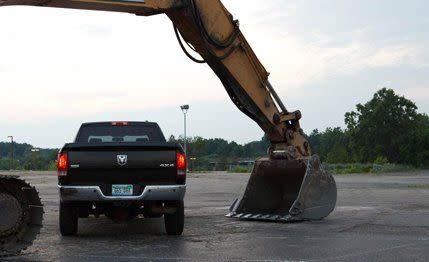
The Laramie’s seat coolers (included with our optional bucket seats) turned out to be a safety feature for at least one driver who “found out you can actually make yourself so uncomfortably cold that it is impossible to nod off while driving. I’m joking. A little.” We generally liked the nav system, which exhibited none of the freezing or hiccups of a similar unit in our long-term half-ton Ram. The navigation still managed to frustrate, however; during one run to the Windy City, the system was seemingly confused by a live stream of info on construction and traffic, Chicagoland’s two main ingredients. “It told me to exit the highway in post-Apocalyptic Indiana and couldn’t decide on a route without recalculating again and again,” wrote the driver. And some found it hard to hit the touchscreen’s virtual buttons—the screen controls radio tuning, and most other functions—while the truck was bounding along without simply stabbing and praying they hit the right one.
Torque, Traction, Towing
The carry-over Cummins diesel six-cylinder suited our needs, providing 350 hp and 650 lb-ft of torque to the rear wheels most of the time or to all four with the turn of a knob. To keep pace with its Ford and GM competitors, Ram introduced a high-output version of the engine with 800 lb-ft of torque for 2011.
We easily made do without the extra grunt, and our towing aficionados—largely our resident race-car owners—hogged the Ram on most summer weekends. They praised the engine-exhaust brake’s cooperation with the transmission’s tow/haul mode, which provided aggressive downshifts. The truck’s cruise control kept pace even when towing on hills, and we observed no tendency to wander on freeway hauls. The integrated brake controller had its fans, and the brake pedal’s initial softness avoided lurching stops with heavy loads, although it required more pressure later to come to a complete halt. (The pedal’s long travel and slop did make for some anxious stops when the truck was unburdened, however.) “An excellent tow rig,” noted technical editor Michael Austin, “but for the price it had better be.” Stability control was only notable by its absence on the spec sheet, not because we missed it; it is now standard for all 2012 HD Rams, however, and this change brings the Ram in line with the rest of the full-size-truck market. Our truck’s only traction aid was its extra-cost limited-slip rear differential.
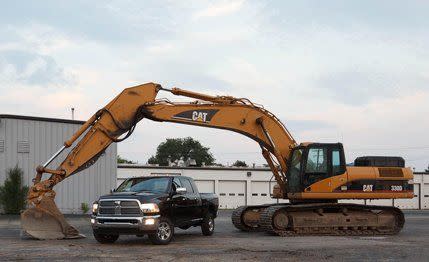
Although its suspension was quite stiff, the Ram’s long, 160.0-inch wheelbase delivered a smoother-than-expected ride while towing or unladen, with only heavily pocked pavement sending big judders through the cabin. This is the longest truck Ram offers, but the black monster was (relatively) easy to maneuver, even taking into account its rather massive turning circle. Slow but accurate steering helped in this regard—and in delivering the straight-line stability we mentioned earlier—as twitchiness isn’t something you want in the helm of something this large. The truck’s acceleration remained consistent over the test, with 8.4- and 8.5-second 0-to-60-mph times being recorded in initial and final testing, respectively.
The big diesel did match our previous 1500 in one surprising way: fuel economy. Burning diesel rather than the smaller truck’s gas, the much heavier 2500 (7260 pounds versus 5680) averaged the same 14 mpg. We saw as high as 17 mpg in highway driving with nothing hooked to the back and between 12 and 15 with a trailer. We averaged 476 miles between fill-ups and saw a high of 516. When we did need to stop, the nav setup’s listing of service stations with diesel fuel proved handy.
Lots of Oil, Let There Be Light
Service costs were about on par with those of the previous long-term Ram. The difference was accounted for by the quantity of oil the diesel requires: 12 quarts. Each of seven oil changes, performed at the onboard computer’s request, ran about $110. Otherwise, this Ram got by with simple maintenance: two fuel filters, two air filters, and several tire rotations and inspections. Between mileage-interval-based services and oil changes (some of which, thankfully, overlapped), the Ram went in 11 times for regular maintenance. Two unscheduled service appointments were required—the first to replace a key-fob transmitter gone haywire and the second to replace an O2 sensor—both of which were covered under warranty. While the truck was in for another service, the dealer replaced the power-steering-reservoir cap as a result of a recall; the power-steering pump provides the pressure for brake boost, and the cap might vent improperly and cause a slow return of the brake pedal. The truck’s original tires lasted the duration of the test, and for once, we didn’t break anything.
We did make an improvement to the truck, one we wish we’d thought of earlier in its stay. Like those of our 1500, this Ram’s headlights demonstrated inadequate illumination abilities. We solved the problem with a set of Sylvania SilverStar Ultra bulbs for the high- and low-beams (about $100 for all four) and recommend the modest investment to anyone buying a new Ram.
Was it too much truck for day-to-day driving? Opinions were mixed, although the Ram had full support as an occasional-use vehicle. A smaller truck or even one with fewer amenities would accomplish most tasks, as would a rental, but for someone with frequent needs, a loaded 2500 like ours has its place in the market. Technical editor K.C. Colwell may have put it best: “I’m not sure why anyone this side of a cattle rancher would buy a truck like this—but God bless ’Murika.” What’s the market like for ranches these days, anyway?
Date: March 2011
Current Mileage: 31,716 miles
Months in Fleet: 11 months
Average Fuel Economy: 14 mpg
Average Range: 476 miles
Service: $888
Normal Wear: $0
Repair: $0
As we’re nearing the end of our long-term test of a diesel-equipped Ram Heavy Duty, engineers have gone and extracted more torque from the Cummins engine—150 more lb-ft, to be precise, thanks to a new computer calibration for 2011. Unlike buyers of early-2011 Ford Super Duty trucks with the Power Stroke diesel, current Ram owners won’t be able to get a simple reflash to the rating of 800 lb-ft, because the Ram update is accompanied by a stouter torque converter. Replacing our torque converter is doable but would void the warranty. How are we getting on without that extra output? Just fine.
Early-Adopter Syndrome
For our purposes, we’ve never found this truck lacking for grunt. Granted, we haven’t yet bumped up against its 12,350-pound towing capacity, but we’re told a 2011 truck identical to our single-rear-wheel 2500 won’t have a higher tow rating anyway. Beyond load lugging, we appreciate the Ram’s torque for its ability to spin our truck’s rear wheels and reorient it, the long wheelbase making this activity particularly easy to control.
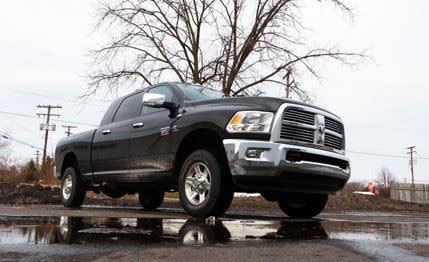
With winter keeping road trips and trailer-tugging junk-car acquisitions to a minimum, the Ram has mostly done commuter duty these past few months. Its longest trip was with senior online editor Jared Gall, who went on an ice-fishing expedition to Minnesota that conveniently coincided with this year’s much-hyped “snowmageddon.” One of few places in the Midwest the storm fully lived up to expectations (or fears) was Chicago, a hard-to-bypass waypoint on the way to the fishing hole. With a couple of shovels and a tow-strap in the bed—Gall wasn’t sure whether he packed them to aid the Ram or other motorists—he and his fellow fishermen went for it. Fortunately for them, the highways through Chicago were cleared by the time they arrived less than half a day after the snow had stopped (not the case for the visible surface streets), and the Ram capably managed what slop they did encounter.
Sensing a Problem
It turns out weather was the least of their worries. Once they arrived in Minneapolis, the check-engine light came on, leading to an aggravating afternoon at a dealer there. Halfway through a full reset of the truck’s computer to address a TSB possibly related to the CEL, the dealer’s computer network crashed, taking the truck’s brain with it. In the words of the service manager, this left our Ram “thinking it [was] a rock.” Better yet, once the network was repaired, the fix only served to extinguish the lamp briefly—it was back on a few hours down the road. When Gall returned to the office, we took the Ram to our local shop, where the cause was found to be a faulty O2 sensor. It was replaced under warranty and we haven’t had any trouble since.

The trip did illuminate one other problem: illumination. The truck’s low-beams don’t cast a big light net, and “the highs don’t do much beyond make the tiny patch of light the lows illuminate brighter—they don’t extend the visible area to an appreciable degree, although they might widen it a smidge,” Gall noted. He tested the lights by driving with the high-beams on and waiting for oncoming drivers to notice and flash their lights back. It took a while.
Have You Seen Oil Prices Lately?
Average mileage between oil changes: 5924. Since the last update, the Ram has been in for its 22,500-mile service (tire rotation and inspection, $19); a stand-alone oil-and-filter change ($109); and the 30,000-mile service, which coincided with the truck’s request for an oil change ($226, including a new fuel filter).
At this rate, we’ll probably visit the dealer only once or twice more for scheduled maintenance and oil swappage. The Ram has about 8000 miles left of its allotted 40K, which has some staffers—the ones with trailers and race cars to put in or on them come summer—looking for ways to keep the mileage down and keep our favorite tow vehicle around a bit longer. Either way, we’ll finish the rig’s term and provide the full report in the next few months.
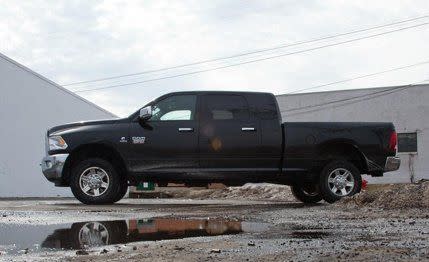
Date: December 2010
Current Mileage: 23,232 miles
Months in Fleet: 8 months
Average Fuel Economy: 14 mpg
Average Range: 476 miles
Service: $662
Normal Wear: $0
Repair: $0
Our Ram 2500’s long-term stay is more than halfway over, and now it’s time for the truck’s true test: winter. We’ll keep towing and hauling in a more limited capacity in the next few months, but the Ram’s main mission will entail driving through messy Midwestern weather. It’s going to be cold, there will be snow, and rear-wheel traction may be intermittently lost. On purpose.
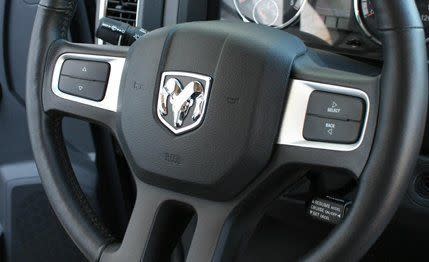
No Traction Control? No Problem
The Ram is the only remaining heavy-duty truck that doesn’t have traction or stability control, instead relying on the driver’s steering-wheel and pedal inputs to figure out where to go (imagine that!). But that fact, combined with the Ram’s non-winter-specific rubber, means lots of rear-wheel spinning when the roads get slick. Luckily, switching to four-wheel drive requires only a twist of the dash-mounted knob. No one has had to click over one more setting to the 4WD system’s low range yet, although our tendency to throw the Ram into lurid drifts could change that, were we to end up in a snow bank or ditch. But when the rear end does attempt to catch up to the front, the truck’s super-long wheelbase means there’s plenty of time for driver correction, so if one of our drivers ends up in a ditch, it’ll likely be to extract other vehicles.
Baby, It’s Cold Outside
The remote-start function has been our dear, dear friend these past few weeks. The diesel takes a little while to warm up—cycling 12 quarts of oil will have that effect—so it’s great to be able to get things toasty before we brave the arctic chill. Doing so not only warms the engine, and therefore the HVAC system, but also turns on the driver’s seat heater (passengers just have to deal with cold keisters) and the heated steering wheel. The wheel’s rim gets plenty warm, but we would like more uniform performance from the heated seat. The seat bottom’s seam breaks the warmth into two areas, which means your mid-thigh remains unheated. This, people, is what’s known as a travesty.
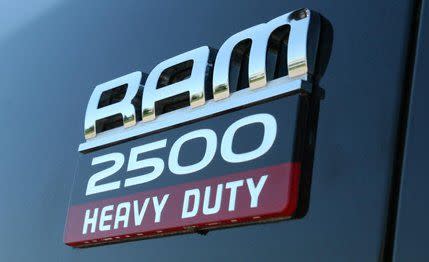
A Little Rattle, a Lot of Service
Okay, so we’re finding minor things to fault. As to actual faults, we have but one slight malfunction to report. The truck’s center console squeaks, and its center armrest/lid rattles. A well-placed elbow will quell the tremors, but we fashioned a shim out of the fast-food napkins we knew we saved for a reason (thanks, Wendy’s!). We’ll ask the dealer to cinch things up on our next visit.
And given the Ram’s track record, a dealer visit is likely not far off. We’ve had only one unscheduled visit—a key-fob replacement we told you about last time—but six required stops so far. The frequent visits are due to the engine computer’s requesting an oil change whenever it’s needed—not at set intervals—and the truck’s required check-ups every 7500 miles; an oil change and scheduled service only overlapped on one occasion. The $553 service total for this quarter reflects three oil changes ($109 a pop), three tire rotations, and fuel- and air-filter replacements (a whopping $175 with parts and labor).
Date: August 2010
Current Mileage: 10,066
Months in Fleet: 4
Average Fuel Economy: 13 mpg
Average Range: 442 miles
Service: $123
Normal Wear: $0
Repair: $0
The lowish mileage total might belie it, but our Dodge Ram 2500 has continued to be the highest-demand weekend ride around the C/D office. Towing and hauling have so far been confined to the Ann Arbor area, which accounts for the truck being slightly behind schedule for a one-year, 40,000-mile stay. A trip to Iowa planned for the coming weekend will be the Ram’s longest sojourn to date, giving it a chance to stretch its legs on straight-as-an-arrow I-80.
We’ve had one issue: The Ram started flashing its turn signals and the headlights came on while it was parked. We interpreted the light show as an SOS and eventually figured out that the communiqué’s source was the remote key. It was repeatedly sending the unlock command to the truck, preventing us from leaving the Ram secured and causing the flashing. Taking the key apart—which it is designed for, to allow battery replacement—and putting it back together seemed to have fixed the problem, but we asked our dealer for a new one just to be safe. The key (a $200 item) was replaced under warranty, no questions asked.
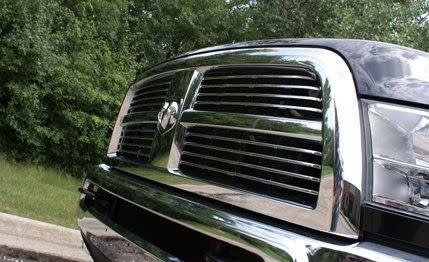
The engine will call out for oil changes as it sees fit, independent of the 7500-mile service interval. Our truck began nagging us before we hit 7500 miles, but we waited so we could roll the oil change in with the rest of the Ram’s first service. It turned out that the rest of the service was merely a tire rotation, but since the Cummins diesel takes 12 quarts of oil, the bill totaled $123. At that price, we wish the same 7500-mile interval specified for the truck’s regular checkups applied to oil changes as well.
Save the Owner’s Manuals!
While we were at the dealership, we asked for a paper copy of the owner’s manual. Chrysler no longer includes them in vehicle purchases but instead drops a quick-reference guide into the glove box and gives buyers a CD-based manual. We found the computerized literature to be lacking and its interface woefully outdated and inscrutable. We weren’t able to find any info about the exhaust brake, for instance, and there were few mentions of our truck’s optional diesel engine. Luckily, the paper copy (free if you ask) includes a supplemental book with diesel-specific info.
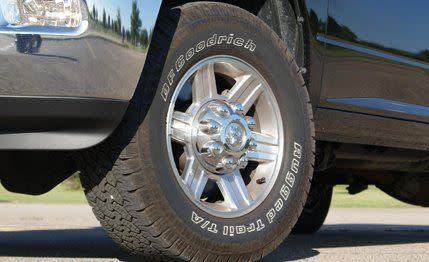
Editors Gillies, Swan, and Yanca have each used our big Ram to tow or haul items for weekend motorsports activities, with all unanimously praising the Cummins engine’s ample power. One of the three (who shall remain nameless, lest he be banned from future Ram use) even wrote that the HD Ram “is more truck than we need.” Sounds like a challenge.
As the mile count climbs, we’ll see about better testing the truck’s limits. If we can find a 12,350-pound trailer and 2100 pounds of something to throw into the bed, we’ll jump on the opportunity. For now, we’ll try to plan some longer excursions and keep on truckin’ toward the 40,000-mile goal.
Date: June 2010
Months in Fleet: 2 months
Current Mileage: 5128 miles
Average Fuel Economy: 13 mpg
Range: 442 miles
Service: $0
Normal Wear: $0
Repair: $0
Unable to go without a tow vehicle for more than five minutes, we lined up another hauler to succeed the 2009 Dodge Ram 1500 that recently left our long-term fleet. Its replacement as resident long-term Ram is this all-black 2010 don’t-call-it-Dodge (even though we still do) Ram 2500 Laramie Mega Cab 4x4 with the optional Cummins diesel. The name is as long as the truck, but, in short, it hauls.
To be honest, a few of us were dreaming of something a little bigger—namely, a 3500 dualie just like the two-tone beauty you might have seen in recent Ram HD ads. And a couple of us wanted a manual transmission. And your author wanted a front bench seat. But it’s good that the less-insane among us won out, because this thing is seriously huge; the dualie wouldn’t have fit in many staffers’ driveways.
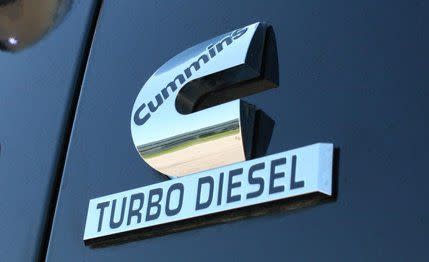
What we ended up with, though, is easily one of the baddest-ass off-road executive limos possible. Everyone is happy with the Mega Cab’s huge back seat, more for its ability to swallow an SUV-equivalent amount of cargo than for the extra legroom. (Most trips so far have been one- or two-up.) The fact that we’re left with a six-foot-four-inch bed instead of the regular- or crew cab’s eight-footer has gone mostly unnoticed.
A Mover, but Not a Shaker
And we’ve already thoroughly tested the Ram’s ability to transport inanimate objects; in just two months, it has helped three editors move to new dwellings, towed our not-yet-completed project Mazdaspeed 5 to finishing school, and lugged one editor’s Spec Miata and its assorted race-weekend accouterments to several track events. The Ram hasn’t sat idle for long since it arrived in April.
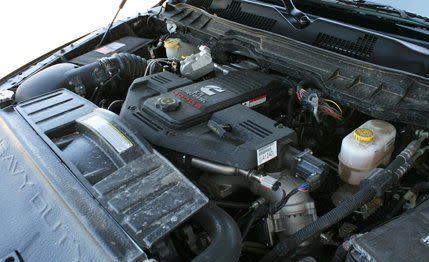
Whether unladen, filled to the headliner with moving boxes, or saddled with a trailer, the HD Ram has proved surprisingly comfortable. Ride was a concern when we spec’d out this truck, given that the HDs ditch the 1500’s coil springs—fitted in the name of increased comfort—for a set of burlier leaf springs. But although it’s not quite as coddling as the coil-sprung 1500, the bigger truck is among the most comfortable heavy-duty rigs we’ve driven. Yes, the ride can be a bit choppy from time to time, but it’s never unacceptably harsh, and this is a freaking truck, after all; it ain’t gonna ride like an S-class.
What’s Inside
Our high level of comfort also owes to the Laramie finery with which the truck is outfitted, plus some of the options. But first, let’s get the truly functional add-ons out of the way. The aforementioned Cummins diesel costs $7615, but that’s before the $1170 credit for the base manual transmission. We went for the six-speed automatic, which cancels the credit and adds another $405. Other functional options were a limited-slip rear diff ($325) and an integrated trailer-brake controller ($230).
To the Laramie’s leather-lined cabin we added bucket front seats ($500) with power adjust, heat, and ventilation; ordering this option also nabs a 115-volt AC outlet and rear-seat heaters. An upgrade from regular all-seasons to all-terrain tires cost $100, a rearview camera was $200, a drop-in bedliner cost $245, clearance lights were $80, a skid plate for the transfer case rung up at a mere $50, and a remote starter was $185. You might call us lazy for adding that last one, but we’ve found it shortens startup times by giving the cylinders the required moment to preheat before we climb up into the cab and absentmindedly twist the key. (On second thought, you can go ahead and call us lazy.) Our truck had a fixed rear window with a defroster instead of the sliding glass; this added an $85 credit. Our single-color paint job deletes the fender flares, saving an additional $100.
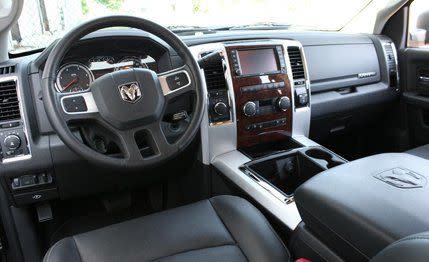
Our total: $54,650, which is certainly a lot for a pickup, but our optioned Ram is some three grand cheaper than the base price of the poshest diesel 2011 Ford F-250, the King Ranch. The Ford’s Power Stroke V-8, however, does deliver an additional 40 hp and 85 lb-ft of torque over our Ram’s 350-horse inline-six with 650 lb-ft of torque. A Ram 2500 SLT Mega Cab with the Cummins and six-speed auto starts at $48,150.
Thus far, there have been no service visits or problems to report. The Cummins diesel has netted a 13-mpg average, which is fair considering the amount of towing the truck has been doing and its prodigious poundage. Empty, our truck tips the scales at nearly four tons, a full 1940 more pounds than our recent long-term Ram 1500. We’re keen to find out if our affection holds up over the next 35,000 miles’ worth of road trips, hauling sprees, and towing adventures.
You Might Also Like

 Yahoo Autos
Yahoo Autos 